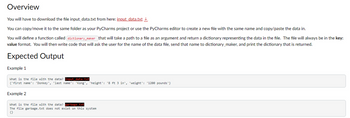
Database System Concepts
7th Edition
ISBN: 9780078022159
Author: Abraham Silberschatz Professor, Henry F. Korth, S. Sudarshan
Publisher: McGraw-Hill Education
expand_more
expand_more
format_list_bulleted
Question
input.txt info:
first name: Donkey
last name: Kong
height: 8 ft 3 in
weight: 1200 pounds

Transcribed Image Text:Overview
You will have to download the file input_data.txt from here: input data.txt
You can copy/move it to the same folder as your PyCharms project or use the PyCharms editor to create a new file with the same name and copy/paste the data in.
You will define a function called dictionary_maker that will take a path to a file as an argument and return a dictionary representing the data in the file. The file will always be in the key:
value format. You will then write code that will ask the user for the name of the data file, send that name to dictionary_maker, and print the dictionary that is returned.
Expected Output
Example 1
What is the file with the data? input_data.txt
{'first name': 'Donkey', 'last name': 'Kong', 'height': '8 ft 3 in', 'weight': '1200 pounds'}
Example 2
What is the file with the data? garbage.txt
The file garbage.txt does not exist on this system

Transcribed Image Text:Specifications
• You should submit a single file called M8A4.py
• You will not submit input_data.txt), but I will have an identical file.
• It should follow the submission standards outlined here: Submission Standards
• Your program must define a function called dictionary_maker that takes a single argument, the path to the data file. It should also:
• Create an empty dictionary called ret_dict that it will populate with the contents of the data file
• Use try/except to gracefully handle a bad file name
Tips and Tricks
• Build it one piece at a time. If you try to do it all at once you're asking for trouble.
• You will need to use the .split() function to do this. You can get more information on that here: https://www.geeksforgeeks.org/python-string-split/ >
• Don't forget to remove the extra new line characters so your output looks like mine.
Hard-Coded
Nothing is hard-coded for this file, but no user input is expected.
Expert Solution
This question has been solved!
Explore an expertly crafted, step-by-step solution for a thorough understanding of key concepts.
This is a popular solution
Trending nowThis is a popular solution!
Step by stepSolved in 4 steps with 3 images

Knowledge Booster
Learn more about
Need a deep-dive on the concept behind this application? Look no further. Learn more about this topic, computer-science and related others by exploring similar questions and additional content below.Similar questions
- The Paste Special dialog box offers the ____ option, which enables you to copy and paste a cell range that contains one or more blank cells where the blank cells are not pasted over any existing values in the range into which they are pasted.arrow_forwardA KeyValuePair object has three properties: Index, Key, and Value Question 49 options: True Falsearrow_forwardmake a payroll application that will have a group box titled Payroll Information. The group box will have textboxes and labels for the user to enter the following information: Employee ID, Employee Name, Hourly Rate, and Weekly Hours Worked. There will also be a Submit and Display button (see left side on example form below).On the opposite side of the form you will need a heading and 2 labels for each of the following: Employee ID, Employee Name, Hourly Rate, Weekly Hours Worked, Overtime Hours Worked, Overtime Pay, Gross Pay, Social Security, FICA, and Net Pay. (see right side on example form below)There should also be a functional button for Clear (clears textboxes and non-identifying labels) and Exit.You should include a class called Payroll that creates private variables for id, name, wage, hours worked, social security Tax, FicaTax, gross pay, net pay, overtime hours and overtime pay. You should also have a private constant for Social Security Tax Percentage set to 6.2% and Fica…arrow_forward
- All controls' attributes influence whether they display on the form during runtime.arrow_forwardPrivate Sub Form_Click() Dim Speed!, Fee Speed = 75 If (Speed > 75) Then Fee = 60 Else If (Speed > 50) Then Fee = 40 Else If (Speed > 35) Then Fee = 20 End If End If End If Print Fee End Sub O Fee = 60 OFee = 40 O Fee = 20.0 O Fee = 75arrow_forwardDecide if the integer, string, or real number data type should be used for each of the following objects. mailing addressarrow_forward
arrow_back_ios
arrow_forward_ios
Recommended textbooks for you
 Database System ConceptsComputer ScienceISBN:9780078022159Author:Abraham Silberschatz Professor, Henry F. Korth, S. SudarshanPublisher:McGraw-Hill Education
Database System ConceptsComputer ScienceISBN:9780078022159Author:Abraham Silberschatz Professor, Henry F. Korth, S. SudarshanPublisher:McGraw-Hill Education Starting Out with Python (4th Edition)Computer ScienceISBN:9780134444321Author:Tony GaddisPublisher:PEARSON
Starting Out with Python (4th Edition)Computer ScienceISBN:9780134444321Author:Tony GaddisPublisher:PEARSON Digital Fundamentals (11th Edition)Computer ScienceISBN:9780132737968Author:Thomas L. FloydPublisher:PEARSON
Digital Fundamentals (11th Edition)Computer ScienceISBN:9780132737968Author:Thomas L. FloydPublisher:PEARSON C How to Program (8th Edition)Computer ScienceISBN:9780133976892Author:Paul J. Deitel, Harvey DeitelPublisher:PEARSON
C How to Program (8th Edition)Computer ScienceISBN:9780133976892Author:Paul J. Deitel, Harvey DeitelPublisher:PEARSON Database Systems: Design, Implementation, & Manag...Computer ScienceISBN:9781337627900Author:Carlos Coronel, Steven MorrisPublisher:Cengage Learning
Database Systems: Design, Implementation, & Manag...Computer ScienceISBN:9781337627900Author:Carlos Coronel, Steven MorrisPublisher:Cengage Learning Programmable Logic ControllersComputer ScienceISBN:9780073373843Author:Frank D. PetruzellaPublisher:McGraw-Hill Education
Programmable Logic ControllersComputer ScienceISBN:9780073373843Author:Frank D. PetruzellaPublisher:McGraw-Hill Education

Database System Concepts
Computer Science
ISBN:9780078022159
Author:Abraham Silberschatz Professor, Henry F. Korth, S. Sudarshan
Publisher:McGraw-Hill Education

Starting Out with Python (4th Edition)
Computer Science
ISBN:9780134444321
Author:Tony Gaddis
Publisher:PEARSON

Digital Fundamentals (11th Edition)
Computer Science
ISBN:9780132737968
Author:Thomas L. Floyd
Publisher:PEARSON

C How to Program (8th Edition)
Computer Science
ISBN:9780133976892
Author:Paul J. Deitel, Harvey Deitel
Publisher:PEARSON

Database Systems: Design, Implementation, & Manag...
Computer Science
ISBN:9781337627900
Author:Carlos Coronel, Steven Morris
Publisher:Cengage Learning

Programmable Logic Controllers
Computer Science
ISBN:9780073373843
Author:Frank D. Petruzella
Publisher:McGraw-Hill Education